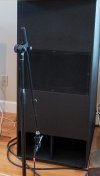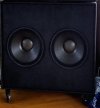I think subwoofers have some sort of output vector, in addition to the well known radiation patterns. I think it comes from the baffle/box the drivers are in, combined with port location, if ported. I've read about wavefront velocity vs acceleration, but don't grasp any of that yet, or have a clue if it describes this "vector" though..
So i don't know how to describe it other than give some examples.
All three of the following sub setups use the same two double 18" drivers. All three are ported to very close to the same f-3 (25-30Hz).
All three are used with a very steep low pass at 100Hz, 96 dB/oct, so there is very little "non-sub / localizable" output from them.
All three sound tonally the same, when it comes to steady state tones.
They differ when it comes to transients.
The first sub is a push-push slot loaded (clamshell type). The slot has a little over the area of one driver's Sd, so almost a 2:1 compression ratio.
Kicks/punches like a beast.

But a bit surprisingly, the PPSL doesn't hit quite as hard as the same two drivers in two standard single 18" ported boxes on top of each other.

And more surprisingly, both the above punch harder than this big baffle guy with the same drivers, that has downward firing ports.

I've spent a lot of time with each of these underneath the same top main speaker, in the same spot in the middle of a fairly big room.
In mono.
One of my favorite tests besides hearing and feeling, is empty beer/coke cans on a table next to listening position.
And see how much SPL it takes to blow the can off the table, with a big bass drop.
The plain old double 18" is the champ, maybe simply because some of the the ports are closer to listening height level.
Dunno....I just know when it comes to transients....bass doesn't seem to be so dang omni after all.



